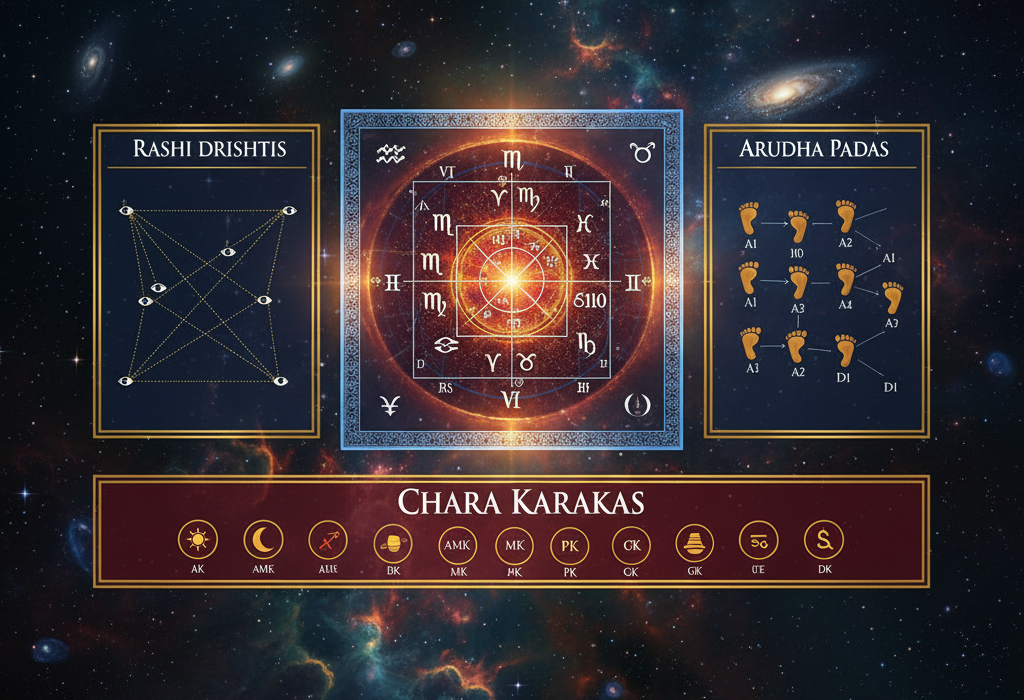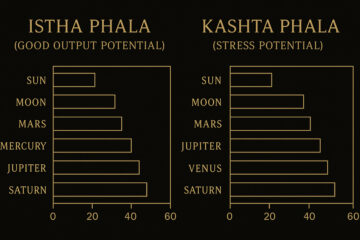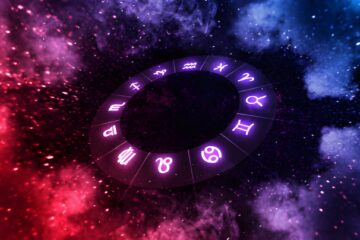Jaimini astrology concepts give us a parallel way to read the chart — one that focuses less on individual planetary aspects and more on sign-to-sign dynamics, image projection, and the soul’s agenda. When we talk about Jaimini astrology concepts, we’re talking about tools like Rashi Drishtis (sign aspects), Arudha Padas (reflections or projections of each house), and Chara Karakas (movable significators that shift based on longitude).
These ideas of Jaimini astrology concepts come from the Jaimini Sutras and are interpreted somewhat differently than classical Parashari astrology. They are subtle, symbol-heavy, and deeply psychological. Every serious student should at least understand their basic function, because they add a layer of “why this is happening” to “what is happening.”
In this guide we’ll walk through three pillars: how Rashi Drishtis work, how to interpret Arudha Padas like AL and UL, and why Chara Karakas — especially the Atma Karaka — are so central in Jaimini. We’ll also talk about how to bring these into real chart work without throwing out Parashara, and why you should not panic if you see something “difficult” in a Jaimini indicator. Difficulty doesn’t mean doom. It usually means curriculum.
Jaimini Astrology Concepts in Practice
The Jaimini system doesn’t try to replace Parashara. It speaks in a different dialect. Parashara tells you events and timing (Vimshottari Dasha, transits, yogas, functional benefic vs functional malefic, and so on). Jaimini describes narrative posture: what your life looks like from the outside, why certain bonds form, and what the soul is actually trying to learn through those events.
You’ll notice a few distinct features when reading Jaimini:
- Rashi Drishti: Signs aspect other signs in a fixed pattern. This is not optional; it’s built into the zodiac. The planets inside those signs inherit that “gaze.”
- Arudha Padas: Each house projects an “image” into the world. Arudha Lagna (AL) is how you are seen. Upapada Lagna (UL) is how partnership and marriage are seen.
- Chara Karakas: Planets take on roles (Atma Karaka, Amatya Karaka, etc.) based on their degrees. These roles become karmic actors in your life story.
Let’s go piece by piece and build this in a way you can actually use in chart work.
I. Rashi Drishtis (Sign Aspects) and How They Shape the Chart
In Parashari astrology, we learn Graha Drishti: individual planets aspect certain houses, like Mars throwing a special 4th and 8th aspect, Jupiter throwing 5th and 9th aspects, Saturn throwing 3rd and 10th, and so on. Jaimini doesn’t start there. Jaimini astrology concepts starts with Rashi Drishti — the relationship of sign to sign. These are sign aspects, not planet-by-planet aspects. Every planet inside a sign inherits that sign’s “line of sight.”
Here are the core Rashi Drishti rules:
- Dual signs (Gemini, Virgo, Sagittarius, Pisces): Any planet in a dual sign aspects all other dual signs. Example: Mars in Gemini aspects Virgo, Sagittarius, and Pisces.
- Fixed signs (Taurus, Leo, Scorpio, Aquarius): Any planet in a fixed sign aspects all movable signs except the one right next to it. So if the Sun is in Taurus, it will aspect Cancer, Libra, and Capricorn — but not Aries (the adjacent movable sign).
- Movable signs (Aries, Cancer, Libra, Capricorn): Any planet in a movable sign aspects all fixed signs except the one right next to it. So Saturn in Libra aspects Taurus, Leo, and Aquarius, but not Scorpio.
A few important things to notice:
- These are sign aspects, not conditional on individual degrees the way Parashari aspects are. They are structural. They last for life.
- If a sign aspects another sign, every planet sitting in that target sign receives that influence, whether or not Parashari aspects would have connected them.
- Because this is sign-level, it’s easier to see broad psychological patterns and reputation patterns than specific event triggers.
Let’s use an example. Suppose Arudha Lagna (AL) — which represents how the world perceives you — falls in Taurus. Venus sits in Libra. Libra (a movable sign) aspects Taurus (a fixed sign) by Rashi Drishti, so the AL in Taurus is getting a Venus signature from Libra. Translation: people tend to perceive you through Venus themes — style, refinement, aesthetics, relational intelligence, maybe a touch of diplomacy. Even if your actual Moon is anxious and your Saturn is grinding away, the projected personality (AL) still looks “Venusian.” This is why Rashi Drishti is so valued in Jaimini: it defines how energies echo across the chart’s surface.
Practical use: When you’re reading career, status, or public image, check which signs Rashi-aspect your AL or your 10th-house-related Arudha (often A10). The nature of those signs, and of their lords, will color how your reputation is perceived. That’s power when you’re doing image work, branding work, or public career analysis.
II. Arudha Padas: Projection, Reputation, and Social Narrative
“Arudha” literally means “mounted,” “risen,” or “reflected.” An Arudha Pada is the projected image of a house. The logic is simple and brilliant: The 2nd house shows resources; A2 (the Arudha of the 2nd) shows how wealthy you appear. The 10th house shows your work; A10 shows how the world reads your career. The Lagna shows you; Arudha Lagna (AL) shows how the world reads you.
Two Arudhas that every student of Jaimini should learn to track immediately:
- Arudha Lagna (AL): Public image, perceived identity, the “brand.” This is not the true self; it’s the social mask, the persona people assume you are.
- Upapada Lagna (UL): Arudha of the 12th house. This represents marriage, partner image, and how the marital bond appears to exist in the world. It’s not only “my spouse,” it’s “what is the visible story of my union?”
A classic relationship test in Jaimini is the positional link between AL and UL. If AL and UL land in a 6/8 or 12/6 type of relationship, tension and mismatch are likely to color the visible relationship narrative. It doesn’t mean “automatic divorce.” It means the self-image (AL) and the marriage narrative (UL) rub uncomfortably. There can be distance, sacrifice, or constant repair work. By contrast, if AL and UL sit 1/7 from each other, that’s not automatically “bad” — 1/7 often shows magnetism, mirroring, and deep engagement. Sometimes that pairing is intense, dramatic, co-dependent, but undeniably bonded.
Now bring in Rashi Drishti. Signs (and planets in those signs) that cast Rashi Drishti on UL describe the spouse’s tone. Venus Rashi-aspecting UL? Expect grace, beauty, pleasing presence, or refined conduct. Mars Rashi-aspecting UL? Expect boldness, assertiveness, and a partner who will confront what’s not working rather than pretend. Jupiter Rashi-aspecting UL? Expect guidance, wisdom, moral or philosophical framing inside the marriage story.
How to start using Arudha Padas in real readings:
- Check AL to understand how others narrate you, especially in public and professional contexts.
- Check UL for the visible story of commitment, not just private compatibility. Are you seen as “stable couple,” “power couple,” “chaotic couple,” “teacher-student dynamic,” etc.?
- Expand slowly to other Arudhas like A10 (public career projection), A2 (perceived wealth), and A9 (fortune / spiritual legitimacy). Don’t try to read all of them at once until you’re comfortable with AL and UL.
One final caution: Arudha is projection. It’s what people think is true. You can look wealthy (strong A2) and still feel financially terrified privately. You can look spiritually evolved (strong A9) and still struggle with faith internally. That gap between AL/Arudhas and the lived emotional truth? That’s where a lot of a person’s suffering sits. As an astrologer, naming that gap gently is powerful and healing.
III. Chara Karakas: Atma Karaka, Amatya Karaka, and the Movable Roles
Parashari astrology uses fixed significators. The Sun broadly represents father, Saturn represents labor and discipline, etc. Jaimini adds a movable system: Chara Karakas. “Chara” means movable. These are planetary roles assigned according to actual degrees in the chart.
The planet with the highest degree in the zodiac (within its sign) becomes the Atma Karaka (AK), the significator of the soul — the core “who am I and why am I here?” planet. The next highest becomes the Amatya Karaka (AmK), which represents guidance, career, and how you enact the soul’s will in the world.
Other Chara Karakas then follow in descending order of degrees:
- Atma Karaka (AK): Soul intent, deep identity, destiny signature.
- Amatya Karaka (AmK): Counsel, career path, practical execution.
- Bhratri Karaka (BK): Siblings, courage, initiative.
- Matri Karaka (MK): Mother, emotional foundation, nurturance.
- Pitru Karaka (PiK): Father, dharma, authority, legacy.
- Putra Karaka (PK): Children, creativity, legacy of mind and heart.
- Gnati Karaka (GK): Obstacles, rivals, wounds, disease areas — where you wrestle.
- Dara Karaka (DK): Spouse and serious partnership themes.
In a standard 7-planet system (Sun through Saturn), you assign these roles down the chain. But when two planets are almost tied by degree, some lineages bring in Rahu to complete the Chara Karaka set. This is often called the mixed Parashara scheme. Rahu can become one of the Karakas when needed. Ketu is never used as a Chara Karaka.
Why is this powerful? Because the AK and AmK dynamic explains a lot about internal alignment. If your Atma Karaka (soul-intent planet) and your Amatya Karaka (career/execution planet) are harmonious — say they’re in trine, or in signs ruled by friendly lords — then the life story tends to feel aligned. “What I feel called to do” and “what I actually do for work” cooperate. If AK and AmK are hostile or afflicted together, you get tension. “What I must be for the world” and “what I need to be for myself” start wrestling. That wrestling doesn’t mean failure. It means karma: you’re being pushed to integrate purpose with responsibility.
We also pay attention to the Dara Karaka (DK) for relationship themes. In Jaimini astrology concepts logic, DK describes partner karma and partnership expectations. You read the DK alongside the 7th house, Venus (for men) or Jupiter (for women, in traditional framing), and the Upapada Lagna (UL). When DK is pressured or in an inimical sign, relationships become intense teachers. When DK is dignified and well supported by Rashi Drishtis, partnership can become stabilizing, nourishing, and inspiring.
IV. How to Use These in Real Predictions
Here’s how these Jaimini tools show up in actual chart work, without throwing away Parashari technique:
Career and Public Role
To judge career, you already know the Parashari checklist: look at the 10th house in D1, its lord, yogas involving the 10th, Saturn (natural significator of labor and structure), and the D10 divisional chart for career expression. Jaimini adds:
- Check the Amatya Karaka (AmK): Is it dignified? Is it getting supportive Rashi Drishtis?
- Check Arudha Lagna (AL) and A10: How does the world perceive your professional identity?
- Check the 10th from AL and also from the AK/AmK if you’re comfortable with that level. A strong planet there often indicates visible authority or recognized expertise.
If AmK is strong across D1, D9, and D10, you’re usually looking at someone whose work-life direction is stable over time. They may adjust roles, but the core function keeps aligning with their internal compass.
Marriage and Partnership
For marriage, Parashara says: read the 7th house and its lord, analyze Venus (for men) or Jupiter (for women in traditional readings), inspect Navamsa (D9), and track relevant dashas/transits. Jaimini layers on:
- Upapada Lagna (UL): the projected story of marriage. How does the union appear to function publicly?
- Dara Karaka (DK): whom you attract and what that partnership teaches you, not just “who you marry.”
- AL vs UL distance: Are AL (self-image) and UL (partnership image) in harsh houses from each other like 6/8 or 12/6? That can mean friction in how “I am seen” vs “we are seen.” Is it 1/7? That can mean strong engagement, magnetism, sometimes intensity.
When UL is well supported by Venus or Jupiter through Rashi Drishti, the visible marriage story tends to be perceived as harmonious, cultured, or mutually respectful. When UL is heavily hit by Mars or Saturn with no benefic support, outsiders may perceive the union as duty-bound, combative, or high-pressure — even if the internal emotional reality is more nuanced.
Atma Karaka and Life Direction
The Atma Karaka shows the soul’s theme. During AK-related dashas (especially in Jaimini’s Chara Dasha system), the person often faces experiences that push them toward inner alignment, which can feel like “spiritual homework.” People sometimes label AK periods as “suffering,” but that’s not accurate across the board. If the AK is strong and well placed in D1 and D9, those periods can feel clarifying, morally centering, and surprisingly rewarding. The stress happens mainly when we resist what the AK is trying to teach.
Also watch the Karakamsa Lagna — the Navamsa sign occupied by the Atma Karaka. Planets placed in or aspecting the Karakamsa Lagna show what the soul is pulled toward. For example, Ketu around the 12th from Karakamsa Lagna can indicate a draw toward renunciation, meditation, or release of material identity, especially later in life. Saturn around Karakamsa can indicate karmic lessons around structure, responsibility, boundaries, and service. None of this means fatalistic punishment. It means “here’s where your evolution concentrates.”
V. Working With Jaimini Responsibly
Jaimini is powerful, but you should not start reading charts by mixing every rule you’ve ever heard. Here are some guidelines so you don’t overwhelm yourself or your client:
1. Keep Parashara as Your Baseline
Parashara tells you what is promised in visible life: yogas, functional benefic vs functional malefic rulership, dasha timing, transits (“dashas propose, transits dispose”), strength metrics like Vimsopaka Bala or Istha Phala, divisional charts like D9 and D10. Jaimini then refines the psychological, karmic, and reputational story around those promises. Don’t throw away Parashara — build on it.
2. Use Rashi Drishtis for Image Patterns and Social Narrative
Rashi Drishti is permanent. It describes lifelong tendencies and reputational flavors. It’s excellent for reading how the world interprets you (AL) and your union (UL), and how authority or influence (A10, GL-style analysis in other systems) appears to operate. But because Rashi Drishti isn’t transit-based like Graha Drishti, don’t try to use it alone for “on which exact date will I get promoted.”
3. Respect Arudha Lagna and Upapada Lagna
Arudhas are about projection. They are not lies, but they are not the whole truth either. A person with a glamorous AL may still feel insecure internally. A marriage that looks perfect through UL could be privately going through deep work. Your job as an astrologer — especially if you’re practicing compassionate, modern Jyotish — is to bridge how it looks and how it feels without judgment.
4. Track Chara Karakas for Karmic Themes
Chara Karakas give you roles. The Atma Karaka tells you what the soul wants. The Amatya Karaka tells you how you practically execute that mission in the world. The Dara Karaka tells you what kind of partner karma you’re walking into. When those Karakas line up harmoniously, life feels coherent. When they clash, life feels like “I know what I should be doing but I keep doing something else.” That tension is not failure. It’s literally the curriculum you signed up for.
5. Don’t Panic-Interpret
This entire system, like Parashara, is not here to scare you. A harsh Rashi Drishti on UL doesn’t mean “guaranteed divorce.” A stressed Dara Karaka doesn’t mean “you’ll never marry.” It means “this arena is where you will grow.” Jyotish is a mirror for conscious evolution, not a sentence. Use it that way.
Important Notes
What is the main difference between Graha Drishti and Rashi Drishti?
Graha Drishti is Parashari: individual planets casting aspects. It’s dynamic, and those aspects become especially relevant during dasha and transit windows. Rashi Drishti is Jaimini: whole signs permanently aspecting other signs. Rashi Drishti creates a lifelong energetic relationship. So Graha Drishti is great for timing and activation; Rashi Drishti is great for reading baseline wiring, reputation, and karmic tone.
Should I apply Rashi Drishtis in divisional charts?
Advanced astrologers sometimes do, especially in D9 and D10, but only after confirming the same pattern in D1. Because divisional charts are mathematical harmonics, you can over-interpret very fast. A healthy rule for students: apply Rashi Drishti primarily in the main chart first, then cautiously in D9 or D10 if (and only if) it repeats the same storyline.
What if Atma Karaka and Amatya Karaka are conjunct but hostile?
When AK and AmK sit together but in signs ruled by inimical lords or under pressure, the person can feel torn between “who I really am” and “what I have to do.” That can look like over-analysis, perfectionism, moral stress, or a career that feels heavy. Still, it often grants very sharp intelligence and leadership ability. Dignity matters — if both planets are strong in D1 and D9, the friction becomes drive rather than burnout.
Does an Atma Karaka Dasha always bring suffering?
No. The Atma Karaka Dasha is about alignment with the soul’s intent. If the AK is healthy — strong dignity, decent support in D9, not brutally afflicted — the AK period can be deeply fulfilling, even if it’s intense. The “suffering” narrative usually comes from resistance. People describe AK periods as “I finally understood my calling,” not just “I was miserable.”
Can Rahu act as a Chara Karaka?
Yes. In the mixed 7/8 scheme, if two planets are tied by degree and you run out of unique assignments, Rahu can step in and take the next Chara Karaka slot. Ketu is never used. Many modern astrologers (including those using software like Jagannatha Hora) work with this mixed approach because it cleanly resolves degree ties in practice.
FAQ
Are Jaimini Dashas like Chara Dasha more accurate than Vimshottari Dasha?
They’re different tools. Vimshottari Dasha (Parashari) is universal and excellent for tracking external events. Chara Dasha (Jaimini) tracks psychological development and karmic unfolding. Ideally, you read them in parallel: Vimshottari says “what,” Chara Dasha says “why you needed that experience for growth.”
How do Arudha Lagna (AL) and Upapada Lagna (UL) actually differ?
AL is your public face — what people assume about you, your perceived persona. UL is the public story of marriage/partnership — how the union is perceived, what narrative surrounds it. The relationship between AL and UL shows how “me” and “us” interact. If they sit 6/8 or 12/6 apart, outside perception may register tension, sacrifice, or emotional distance. If they’re 1/7, it can show magnetic pull, high involvement, strong projection of “we.”
Can Atma Karaka and Amatya Karaka define life purpose?
Yes. The AK shows what the soul is hungry to learn. The AmK shows how you practically move that hunger into the world — career path, service path, or mission. When AK and AmK are compatible by sign lord friendship or Rashi Drishti support, life feels aligned and purposeful. When they clash, life purpose is still there — it just feels like work to live it consciously.
Should I mix Jaimini and Parashara techniques in one reading?
Eventually, yes — but only after you can do each system cleanly on its own. Parashara gives you the structural map: functional benefic vs functional malefic rulership, yogas, dashas propose / transits dispose, divisional charts like D9 and D10 for refinement. Jaimini astrology concepts gives you projection (Arudhas), karmic storyline (Chara Karakas), and sign-level influence (Rashi Drishti). If you blend them too early, you’ll get contradictions you can’t resolve. Get fluent in Parashara first, then layer Jaimini.
What is Karakamsa Lagna and why does it matter?
The Karakamsa Lagna is the Navamsa sign occupied by the Atma Karaka. Read that sign as a special lagna for spiritual orientation. Planets sitting in Karakamsa or aspecting it describe where the soul feels called. For instance, Ketu around the 12th from Karakamsa is often read as detachment, moksha-seeking, or a strong pull to surrender identity and merge into something larger. Saturn around Karakamsa can signal a life of service, responsibility, and structured karmic work. This is not doom. It’s your curriculum.
Stay With Much Needed Astro
Much Needed Astro is here for serious students who want real Jyotish, not recycled soundbites. We teach you how to work with Jaimini astrology concepts — Rashi Drishti, Arudha Lagna, Upapada Lagna, Chara Karakas, Karakamsa Lagna — and then connect them back to Parashara’s dashas, divisional charts, and functional benefic vs functional malefic logic. You learn to see both the event and the meaning behind the event.
If you’re serious about studying real Jyotish or Jaimini astrology concepts, stay with Much Needed Astro — no fluff, no fear-mongering, just clarity you can actually use.



